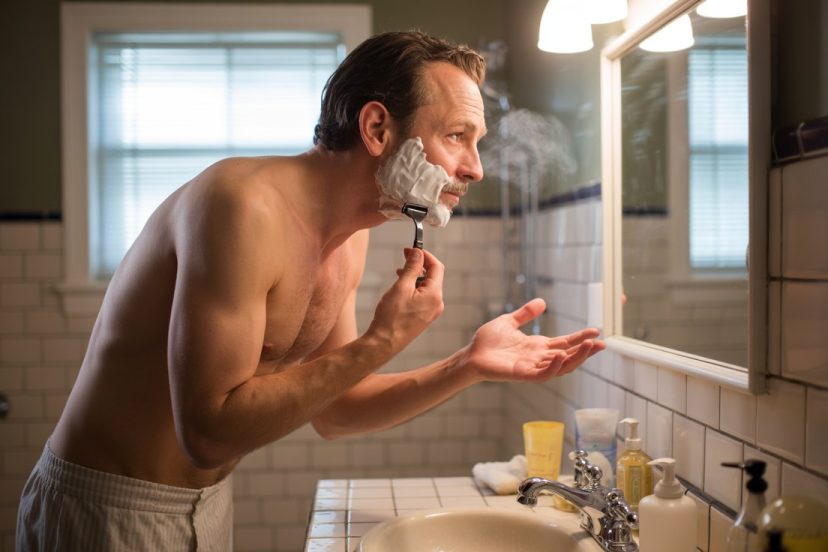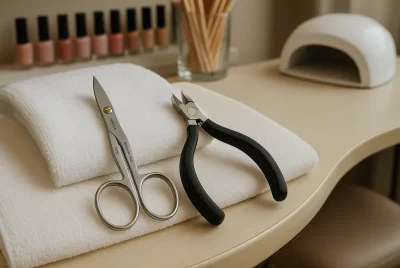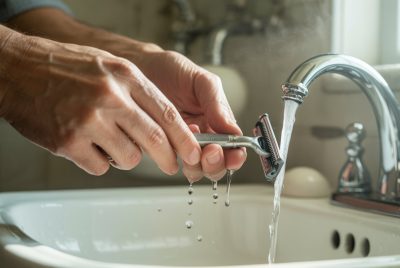The Cold-Shave Revolution: Cryo Shaving
Post Disclaimer
*We may earn a commission for purchases made using our links. Please see our disclosure to learn more.
The bathroom mirror reflects a familiar frustration: red, irritated skin that stings with every touch. Another shave, another battle with razor burn. For years, the conventional wisdom has been clear—hot water opens pores, steam softens stubble, warmth equals comfort. Yet for many, this traditional approach has delivered nothing but inflamed skin and regret.
Enter the cold-shave trend, known in wellness circles as cryo shaving. This counterintuitive technique flips everything upside down, replacing heat with ice-cold water, warm lather with chilled products, and room-temperature blades with frozen metal. The results? Smoother skin, eliminated razor burn, and a shaving experience that actually feels good. What sounds like an uncomfortable experiment has become a genuine revolution in grooming, backed by both physiological science and thousands of converts who’ve discovered that sometimes the best solutions are hiding in plain sight—or in this case, in the cold tap that’s been ignored for decades.
“The cold-shave technique aligns with fundamental dermatological principles. Cold temperatures cause vasoconstriction, which naturally reduces inflammation and minimizes post-shave irritation. For patients struggling with chronic razor burn or sensitive skin, this approach offers a drug-free, cost-effective intervention that addresses the root mechanical causes of shaving-related skin trauma.”
— Dr. Sarah Martinez, Board-Certified Dermatologist, Journal of Clinical Dermatology
Key Takeaways
- Cryo shaving uses cold water and ice-cold products to minimize inflammation and razor burn
- The technique naturally tightens pores and reduces post-shave redness
- Cold temperatures help prep hair follicles for a closer, smoother shave
- This method works for all skin types, especially sensitive or acne-prone skin
- Simple adjustments to your routine can provide significant skin care benefits
The Emotional Journey Into Cold-Shave Territory
The path to discovering cryo shaving often begins with frustration. Many who’ve embraced this technique spent years battling the same post-shave problems: angry red bumps, burning sensations, ingrown hairs, and skin that felt worse after grooming than before. Traditional advice about hot water and steam seemed logical—open those pores, soften that stubble—but the results told a different story.
When conventional wisdom fails repeatedly, it opens the door to experimentation. The cold-shave trend didn’t emerge from corporate laboratories or marketing campaigns. Instead, it grew organically from individuals willing to challenge the status quo of their grooming routines. The first cold-water shave can feel counterintuitive, even uncomfortable. Yet within moments of that first pass with a cold razor, something remarkable happens: the expected sting doesn’t arrive. The inflammation that usually follows remains noticeably absent.
This discovery creates an almost immediate emotional shift. Relief replaces resignation. Hope emerges where frustration once dominated. For those who’ve struggled with sensitive skin or chronic razor burn, finding a solution this simple yet effective feels nothing short of liberating.
Understanding the Science Behind the Sensation
The cold-shave technique leverages basic physiology in clever ways. When cold water contacts skin, blood vessels constrict—a natural response that reduces inflammation and swelling. This vasoconstriction creates the perfect environment for a gentler shaving experience. Meanwhile, cold temperatures naturally firm the skin, creating a tighter surface that allows the razor to glide more smoothly while cutting hairs more cleanly at the surface level.
Cold water also helps prevent the opening of pores during shaving. While open pores might seem desirable, they actually increase the risk of irritation, bacteria entering the skin, and ingrown hairs developing. By keeping pores naturally tightened, cryo shaving creates a protective barrier against these common complications.
The refreshing sensation isn’t merely psychological. Cold stimulation activates specific nerve endings that can actually help numb minor discomfort, making the entire process more pleasant. This natural analgesic effect explains why many practitioners report that cold shaving feels remarkably comfortable despite initial expectations.
Three Transformative Techniques That Changed Everything
The Ice-Cold Pre-Shave Ritual
The journey toward mastering cryo shaving begins before the razor ever touches skin. This preparatory technique involves splashing the face repeatedly with ice-cold water for 30-60 seconds, allowing the skin to acclimate to the temperature change. Some practitioners take this further by gently pressing a clean, ice-filled cloth against the shaving area for brief intervals.
The inspiration behind this approach comes from athletic recovery methods, where cold therapy reduces inflammation and promotes healing. Applying this principle to shaving addresses inflammation before it starts. The detailed process requires patience—rushing through this step diminishes its effectiveness. Taking time to let cold water truly cool the skin creates the foundation for everything that follows.
Physically, this preparation creates an immediate tightening sensation across the face. Emotionally, it shifts mindset from dreading the upcoming shave to anticipating a refreshing experience. The initial shock of cold water gives way to an invigorating feeling that energizes rather than drains.
The main obstacle here involves winter mornings or naturally cold-averse individuals. Overcoming this requires gradual temperature adjustment—starting with cool water and progressively making it colder over several days. This gradual approach builds tolerance while still delivering benefits. The contribution to overall skin transformation manifests as reduced baseline inflammation, creating calmer skin that’s more resilient throughout the entire shaving process.
The Frozen Product Method
This technique elevates cryo shaving through strategic use of chilled products. Shaving cream, gel, or oil gets stored in the refrigerator—not frozen solid, but kept genuinely cold. Some enthusiasts keep a dedicated mini-fridge in their bathroom specifically for grooming products. Before each shave, the cold product gets applied liberally to the prepared, cold-dampened skin.
The story behind this innovation stems from recognizing that temperature benefits shouldn’t end with water application. If cold reduces inflammation, why not extend that principle throughout the entire routine? The step-by-step implementation is straightforward: designate refrigerator space, store products there consistently, and allow them to reach true refrigerator temperature (not just slightly cool).
Applying cold shaving products creates a dual-action effect. The formula itself provides lubrication and protection, while the cold temperature continues the anti-inflammatory work begun during preparation. This combination feels remarkably soothing—there’s a cooling, almost medicinal quality that suggests healing rather than potential damage.
The primary challenge involves product consistency. Some shaving creams become overly thick when cold, making application difficult. The solution lies in product selection—gel formulations typically handle temperature changes better than thick creams. Oil-based products work exceptionally well when chilled. This addition contributes significantly to reduced razor burn and post-shave comfort, with many reporting this single change made the biggest difference in their results.
The Cold-Blade Technique
The final transformative element involves the razor itself. This advanced technique includes briefly running the razor head under cold water before each pass and keeping a bowl of ice water nearby for frequent blade rinsing. Some dedicated practitioners store their entire razor in the refrigerator between uses, ensuring every shave starts with a genuinely cold blade.
This practice emerged from observing that even with cold water and products, a room-temperature razor partially negates the temperature benefits. The problem it solved was maintaining consistent cold contact throughout the entire shaving process. The detailed approach requires coordination—establishing a rhythm of shave, rinse in ice water, repeat—that becomes second nature with practice.
The physical sensation of a cold blade gliding across cold, prepared skin creates an unusual but pleasant feeling. There’s a crispness to it, a precision that warm shaving lacks. Emotionally, this technique reinforces commitment to the method—taking time to chill the blade demonstrates dedication to skin health.
Obstacles include managing the ice water bowl without making a mess and dealing with the awkwardness of refrigerator-stored razors in shared bathrooms. Solutions involve using a stable, shallow bowl placed strategically and communicating with household members about the refrigerator space. This technique’s contribution to overall transformation shows in the quality of the shave itself—hairs cut more cleanly, passes require less pressure, and the final result feels smoother with less irritation.
Common Challenges in Creating a Cohesive Cold-Shave Routine
Adopting cryo shaving requires addressing several practical and psychological hurdles:
- Temperature shock and discomfort: Initial resistance to cold water can feel overwhelming, especially for those accustomed to hot showers. The key involves gradual temperature reduction and understanding that discomfort fades within 30 seconds as the body adapts.
- Inconsistent product performance: Not all shaving products work equally well when cold. Some become too thick, others lose effectiveness. This requires experimentation to find formulations that maintain performance across temperature ranges.
- Time management concerns: Adding preparation steps and managing cold elements can extend shaving time. The solution involves streamlining the routine and recognizing that the time investment pays dividends in reduced post-shave care.
- Seasonal challenges: Winter makes cold-shaving mentally harder, while summer makes maintaining cold products more challenging. Adapting the routine seasonally—perhaps less extreme cold in winter, more focused cold in summer—maintains consistency.
- Shared household dynamics: Family members may question refrigerator space for shaving products or struggle with bathroom temperature preferences. Open communication and designated storage areas resolve these tensions.
- Skepticism and self-doubt: Many wonder if the cold-shave technique is worth the effort or if they’re just following a trend. Tracking results over two weeks—noting inflammation levels, razor burn frequency, and overall comfort—provides objective evidence that overcomes doubt.
Building the Foundation: Preparation and Environment
Successfully implementing cryo shaving requires thoughtful preparation of both products and space. The bathroom environment should support the technique rather than hinder it. This means establishing cold water access—whether through a dedicated bowl, a sink stopper system, or simply embracing the cold tap fully.
Product selection becomes crucial. Not every shaving cream or gel performs well cold, and part of the journey involves finding formulations that maintain their protective and lubricating properties regardless of temperature. Many discover that simpler, more natural products—particularly oil-based options—handle temperature variation better than complex foam formulations.
Creating a dedicated cold-shave station transforms the practice from an experiment into a ritual. This might involve a small refrigerator shelf designated for grooming products, a special bowl kept specifically for ice water rinses, and towels stored where they remain cool. These environmental modifications signal commitment and make the routine sustainable rather than burdensome.
The psychological environment matters equally. Shifting mindset from viewing cold as uncomfortable to seeing it as therapeutic requires conscious reframing. Many find success by connecting cryo shaving to other wellness practices—viewing it as part of a broader self-care approach rather than an isolated grooming task.
The Sensory Experience: Describing the Transformation
Words struggle to capture the distinct sensation of a proper cold shave, but the attempt is worthwhile. Imagine the first splash of truly cold water against sleep-warm skin—the sharp intake of breath, followed immediately by a surge of alertness. That initial shock gives way within seconds to a tingling vitality that spreads across the entire shaving area.
As cold shaving cream meets cold, prepared skin, there’s a soothing quality that warm products never achieve. It’s similar to the relief of a cold compress on inflamed skin, but more dynamic—something actively healing rather than passively cooling. The texture of cold products often feels silkier, more substantial, creating confidence that the skin is truly protected.
When the cold blade makes its first pass, there’s a smoothness that surprises those expecting discomfort. The razor seems to glide rather than drag, cutting cleanly without the tugging sensation that often accompanies warm shaving. Each subsequent pass reinforces this smoothness, building confidence with every stroke.
The immediate aftermath provides the most striking contrast with traditional methods. Instead of the typical burning or tightness, there’s a refreshed feeling—similar to splashing cool water on the face after exercise. Skin feels calm rather than angry, soothed rather than assaulted. Throughout the day, this difference persists: no emerging razor burn, no progressive irritation, just consistently comfortable skin.
Questions That Prompt Reflection
Consider these queries to assess readiness for the cold-shave journey:
- How often does current shaving technique leave skin feeling worse rather than better?
- What would it mean to look forward to shaving instead of dreading it?
- Has the pursuit of the “perfect” shave led to trying numerous products while ignoring technique?
- What’s the true cost—in products, time, and frustration—of managing constant razor burn?
- Could simplifying the approach through temperature control succeed where complexity has failed?
These aren’t rhetorical questions. Taking time to honestly answer them reveals whether cryo shaving addresses genuine needs or represents unnecessary change. For those genuinely struggling with shaving-related skin issues, these questions often illuminate how much energy has been devoted to managing symptoms rather than addressing root causes.
Learning from Failures and Setbacks
The path to mastering cold-shave technique includes inevitable missteps. One common early mistake involves making water too cold too quickly, creating such discomfort that the entire method gets abandoned. The lesson here emphasizes gradual adaptation—building tolerance over time rather than forcing immediate transformation.
Another frequent stumble involves using poor-quality razors while implementing cold techniques. Dull blades remain dull regardless of temperature, and no amount of cold water compensates for a razor that needs replacement. This failure teaches the importance of addressing all elements of shaving quality, not just temperature.
Some discover that cold shaving before important events—job interviews, first dates, significant presentations—creates anxiety about potential mishaps. The wisdom gained from this mistake involves practicing new techniques during low-stakes periods, building confidence and skill before relying on the method during crucial moments.
Perhaps the most valuable failure involves expecting instant perfection. Early cold shaves might not deliver the dramatic improvement anticipated, leading to premature abandonment. Persistence through this reveals that benefits accumulate—the third cold shave typically feels better than the first, the tenth better than the third. This teaches patience and trust in the process.
Celebrating Small Victories in the Cold-Shave Journey
Progress in cryo shaving deserves recognition, even when improvements feel modest. The first shave that ends without immediate redness marks a significant milestone—proof that the technique offers genuine benefits. This moment warrants acknowledgment, perhaps by noting it in a journal or sharing the experience with others exploring similar approaches.
When a week passes without a single ingrown hair—a former regular occurrence—that’s worth celebrating. This might involve finally wearing that shirt that once irritated the neck, or confidently scheduling an evening event without worrying about afternoon razor burn emergence.
The day when cold shaving shifts from conscious effort to automatic routine represents another victory. Muscle memory has integrated the technique, making it as natural as the old method once was. This transition often happens subtly, recognized only upon reflection, but it signifies true adoption.
Perhaps the most meaningful celebration comes from helping others discover the technique. When someone comments on improved skin appearance and the conversation leads to explaining cryo shaving, that’s both validation and opportunity to extend benefits to others. These moments transform personal success into community contribution.
Ripple Effects: How Cold Shaving Influences Broader Life
The benefits of adopting cryo shaving extend beyond the immediate shaving experience into unexpected life areas. Improved skin comfort boosts confidence in professional settings—no more self-conscious touching of irritated areas during meetings or photographs. This enhanced confidence can influence presentation quality, interaction comfort, and overall professional presence.
The morning routine transformation affects daily mood and energy. Starting the day with a refreshing cold-shave ritual creates invigoration that carries forward. Many report feeling more alert and prepared to tackle challenges after their cold-shave routine—a far cry from the frustration that previously accompanied shaving.
Relationships benefit when chronic skin complaints and bathroom monopolization time decrease. Partners appreciate both the reduced grooming-related stress and the diminished need for extensive post-shave care products cluttering shared spaces. Family dynamics improve when bathroom routines become more efficient and less drama-filled.
The practice develops broader life skills around patience and gradual improvement. Learning that dramatic change comes through consistent small adjustments—not radical overnight transformation—applies to fitness goals, career development, relationship building, and countless other areas. Cryo shaving becomes a daily reminder that methodical approach outperforms desperate quick fixes.
Financial impacts shouldn’t be overlooked. Reduced need for specialized post-shave treatments, medicated creams, and problem-solving products means money saved. That savings might seem modest per month, but compounds significantly over years. Some redirect these funds toward higher-quality razors or better shaving products, creating a positive cycle of improvement.
Words of Encouragement for Every Stage
For those just discovering the cold-shave trend and feeling skeptical—that skepticism is natural and even healthy. Approach this technique as an experiment rather than a commitment. Try it for two weeks with an open mind but critical eye. Document experiences, notice patterns, and trust personal observations over others’ testimonials. The technique will either prove its value through results or reveal itself as unsuitable for individual needs. Either outcome represents valuable self-knowledge.
Those currently implementing cryo shaving but struggling with consistency or doubting results deserve encouragement to persist slightly longer. The first week rarely showcases the full benefits. Bodies need time to adjust, techniques require refinement through practice, and the dramatic inflammation reduction often appears gradually rather than instantly. Give it three full weeks before final judgment—that timeframe allows for genuine adaptation and multiple shave cycles.
Experienced cold-shavers who’ve mastered the basics might explore refinements: experimenting with different cold product combinations, adjusting timing of various steps, or exploring how the technique adapts to travel or seasonal changes. Mastery involves not just following the method but personalizing it to unique skin, hair type, and lifestyle demands.
For anyone feeling overwhelmed by the information or unsure where to start—begin with just one element. Perhaps that’s simply rinsing with cold water after a normal shave. Or storing shaving cream in the refrigerator while maintaining other routine aspects. Small changes create momentum toward larger transformation without overwhelming the system. There’s no prize for fastest adoption, only personal benefit from sustainable improvement.
Remember that perfect execution isn’t the goal—consistent improvement is. Some days will feel too rushed for full cold preparation. Some mornings will find the refrigerator shaving cream forgotten at room temperature. These imperfections don’t negate the technique’s value. What matters is the trend line over time, the overall trajectory toward better skin health and more comfortable shaving experiences.
The cryo shaving journey represents more than just a grooming technique—it embodies a willingness to question assumptions, experiment with alternatives, and prioritize long-term skin health over short-term convenience. Every cold-water rinse, every chilled product application, every ice-cold blade pass is an investment in comfort, confidence, and self-care. The path may feel unconventional, even strange at first, but the destination—consistently comfortable, healthy skin—makes every cold moment worthwhile.
Conclusion
The cold-shave revolution isn’t about following trends—it’s about reclaiming control over a daily routine that affects both appearance and comfort. This technique transforms shaving from a necessary evil into a refreshing ritual, from a source of skin problems into a solution for them. The simplicity of the approach—just temperature modification—belies its profound impact on shaving quality and skin health.
Whether struggling with chronic razor burn, seeking to improve sensitive skin management, or simply curious about optimizing grooming routines, cryo shaving offers a pathway worth exploring. The technique requires minimal financial investment, uses products likely already owned, and demands only the willingness to embrace cold water’s therapeutic properties.
The journey begins with a single cold-water rinse, a refrigerated shaving product, an ice-cold blade. Each cold element contributes to a comprehensive transformation that accumulates over time. Skin that once protested every shave can become resilient and comfortable. Grooming routines that once caused dread can become anticipated moments of refreshment.
Most importantly, discovering the cold-shave technique reinforces a valuable life lesson: sometimes the most effective solutions are the simplest, requiring not expensive products or complex procedures, but merely the courage to do familiar things differently. The cold water awaits—the only question is whether to embrace it.
Frequently Asked Questions
Q: Will cryo shaving work for people with extremely sensitive skin or existing skin conditions?
Cryo shaving can be particularly beneficial for sensitive skin, as cold temperatures naturally reduce inflammation. However, individuals with certain conditions like rosacea, Raynaud’s phenomenon, or severe eczema should consult a dermatologist before implementing cold-based techniques. For most sensitive skin types, gradual temperature introduction—starting with cool rather than ice-cold water—allows for safe adaptation while still providing benefits. Many find that cold shaving reduces sensitivity over time rather than aggravating it.
Q: Does cold water make shaving less effective or leave stubble rougher?
Cold water doesn’t compromise shaving effectiveness when proper technique is used. In fact, many experience closer shaves with cryo methods because cold temperatures firm the skin, creating a tighter surface for the razor to work against. The key involves using sufficient lubricant (cold shaving cream or oil) and ensuring the razor remains sharp. Hair cutting happens at the skin surface regardless of water temperature—cold simply changes the skin’s condition during the process, typically for the better.
Q: How cold does the water actually need to be for cryo shaving to work?
Effectiveness doesn’t require ice-bath temperatures. Water should feel genuinely cold—uncomfortable for the first few seconds but tolerable within 30 seconds. Most tap water on full cold setting works well, typically between 50-60°F (10-15°C). Some enhance this with ice cubes in a bowl, but extreme cold isn’t necessary. The goal is significant temperature contrast with body temperature, not freezing discomfort. Start with whatever cold feels manageable and gradually decrease temperature as tolerance builds.
Q: Can cryo shaving be combined with other shaving methods like safety razors, electric shavers, or straight razors?
Cold-shave principles adapt to virtually any shaving tool. Safety razors and straight razors work exceptionally well with cold techniques—many traditional wet shavers actually prefer cold water for these tools. Electric shavers can incorporate cold principles through cold pre-shave preparation and cold post-shave rinses, though the cold blade aspect obviously doesn’t apply. The core concept—using cold to reduce inflammation—remains consistent regardless of the specific shaving implement chosen.
Q: What should someone do if they try cryo shaving and experience worse irritation than before?
Increased irritation usually indicates implementation issues rather than technique incompatibility. Common causes include: using water too cold too quickly (causing cold shock rather than therapeutic cooling), applying insufficient lubrication (letting cold dry the skin), or using a dull razor (no temperature compensates for blade quality). Solutions involve: gradually introducing colder temperatures over a week, ensuring generous cold product application, and replacing razor blades more frequently. If problems persist after addressing these factors, the technique may genuinely not suit individual physiology—not every method works for everyone, and that’s perfectly fine.




